|
Maat-ka-Ra Hatshepsut |
last update:
11.02.2010
|
| |
Way-stations |
|
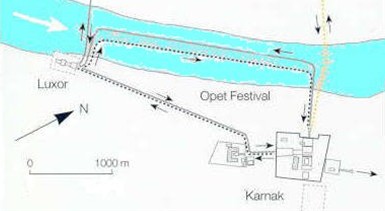
| Ceremonial ways of the Opet feast |
|
The route of the Opet-Feast from the Karnak-temple to the Luxor-temple during
the reign of Hatshepsut is described on the south wall of the
Red Chapel in registers 3 and 5. |
|
On the way to Luxor-temple the procession most likely left the temple through a
southern gate - probably the 8th pylon. According to the description
on the 3rd register the procession took the overland route
along the 6 way-stations and passing the temple of Kamutef and the temple of Mut
(see below). |
|
According to the scenes of the 5th register the procession returned to Karnak by
boats. However, the surviving scenes on the Red Chapel provide no information by
which gate the procession entered the temple of Karnak. Therefore, we do
not know whether the procession entered the temple of Karnak at any time through
the rwtj wrtj (= great double-winged door of a temple or palace; Hannig,
Ägypt.-Deutsch., p. 461) at the western side. |
|
Thus, the sketch above shows all possible and - at different times some used -
routes, e.g. its is known from the presentation of the Opet-Feast in the great
colonnade of the temple of Luxor that during the reign of Tutankhamun the
procession used boats on both ways. |
| As Hatschepsut has reported on the south wall of the
Red Chapel
she had built 6 way-stations (barque shrines) along the ceremonial way from Karnak- to Luxor-temple.
After the barque of Amun had left the temple Ip.t-Sw.t ("Elected place", today Karnak-temple)
at the beginning of the Opet feast, it made "rest" in each of these way-stations
as the blocks of the 3rd register of the south wall of the
Red Chapel reports
|
| Some remains of a way-station were found in the
Luxor-temple built in the Triple Shrine
by Rameses II. Presumably, these stone blocks and columns had been
part the 6th way-station which probably had stood not far from the present entrance
of Luxor-temple.
|
| The remains of another way-station were found easily accessible on the ground opposite to the
temple of Kamutef. The remains of the other four way-stations are presumably
buried together with the remains of the Alley of Sphinxes under the modern city of Luxor.
|
|
The recent excavations of the Alley of Sphinxes which are part of the Luxor City Development
Plan did not bring to light additional remains of a way-station. |
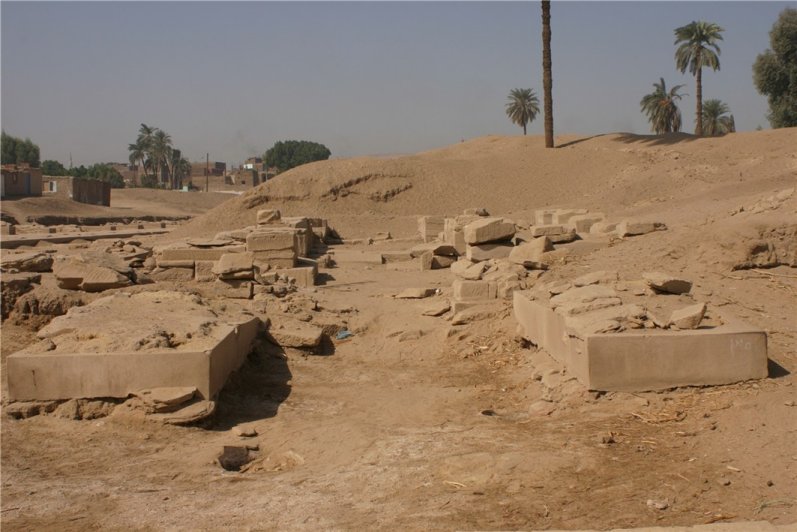
| The remains of the way-station which is located
opposite to the temple of Kamutef,
view along the temple axis from the east to the west.
|
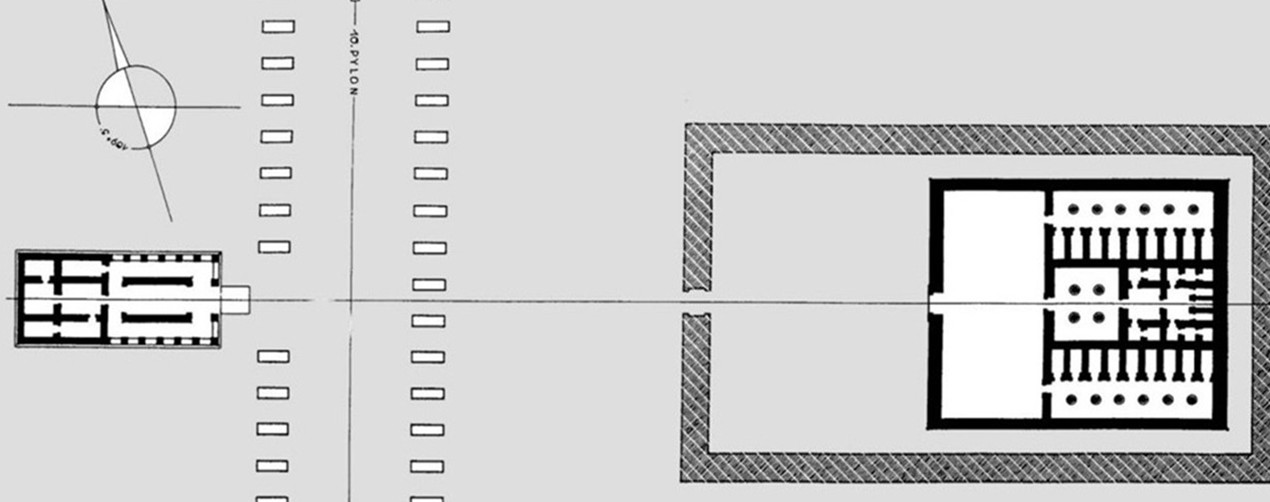
| Location and floor plan of the way-station (left)
opposite of the temple of Kamutef (right).
|
| The remains of the building opposite to the temple of Kamutef
presumably belong to the 1st way-station of the Opet feast which was mentioned
in the Red Chapel, according to Otto (1952), with the name "Amun in front of the stairs of the
pr hn"
(see photo below).
|
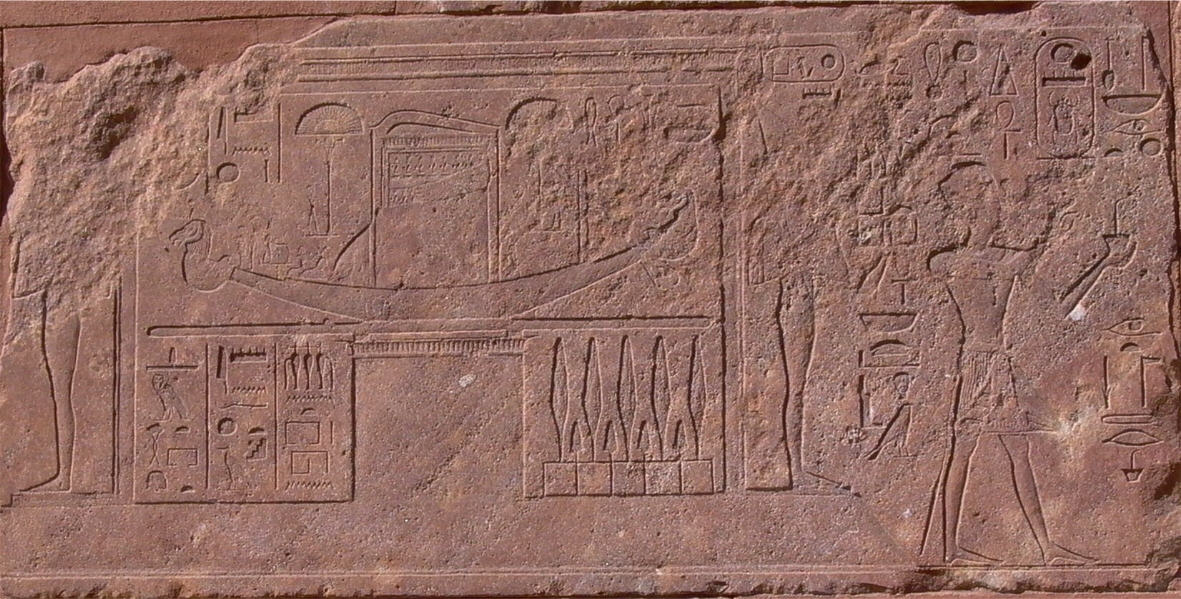
| At the 1st way-station Thutmosis III (right) welcomes the barque
of Amun with offerings,
thereafter, the barque is put on the pedestal inside the way-station; on its
left side of the shrine (next block) Hatshepsut is shown offering in front of
the barque of Amun. |
| The way-station was, like the opposite temple of Kamutef,
no uniform construction because several construction phases could be proved.
Ricke supposed that both temples belonged together formally and thematically
and, hence, the extensions and alterations might have occurred in both temples
during the same epochs. In its final form the way-station consisted on the
eastern half of a barque shrine with a peripteros and on the western side of a
barque shrine with as closed gallery.
|
| Like the temple of Kamutef the whole way-station stood on a
foundation of sandstone blocks. The foundation consisted in the main part of two
layers of stone blocks which were about 1.15 m thick. However, the corners were
strengthened by two additional layers so that here 4 layers with a whole
thickness of 2.5 m lay on top of each other. The foundation rose about 35 cm
from the ground as proved by secondarily produced scratches in the smoothed
edges of the corners. On the eastern side and along the temple axis an outside ramp led
up to the basis. Later, this ramp was taken down and replaced by a new inside
ramp when a pylon was built in front of the temple and die temple district was
enclosed by a wall. Later numerous blocks from the
foundation were taken away, other had disintegrated or had sunken down in the
soft ground. Such damages must already have occurred during the time of
utilization, because repair in the foundation could be proved (e.g.
installation of an altered pillar capital under Rameses III).
|
| Beside the foundation and the eastern ramp the eastern barque shrine and its
peripteros belonged to the original parts of the temple. From the walls of this
barque shrine the lowest layer of sandstone blocks has been preserved.
These blocks reached in each case completely through the wall, they were very
carefully worked and joined together. The east and west side of the barque
shrine opened completely to approx. 3.5 m wide passages. From most pillars of
the peripteros larger parts of the lower row of blocks have been preserved, also
from the barriers between the pillars. Merely on the southeast corner the
pillars and barriers have completely disappeared by disintegration, but remains
of the preparatory drawings on the plaster complemented the reconstruction.
|
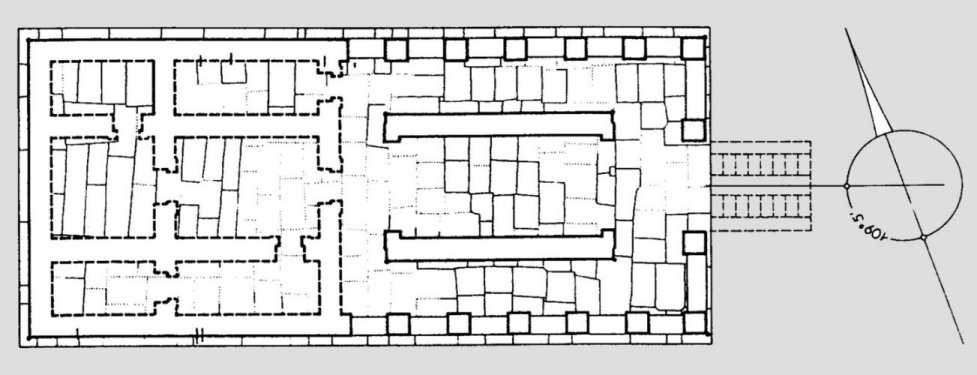
| The floor plan of the way-station according to
Ricke (1954); below
the remains of the eastern part of the way-station (right part of the temple
according to the floor plan above) with the surrounding gallery (= peripteros =
ambulatory). |
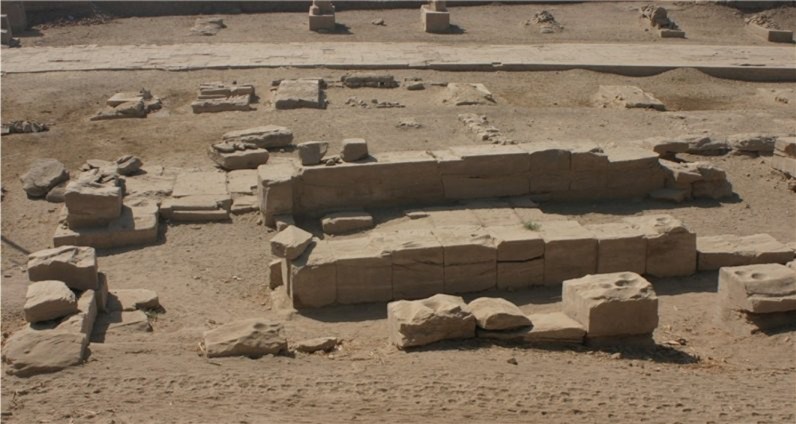
| The original form of the way-station can be reconstructed based on the remains
of the building. The eastern barque shrine had been established as an independent
construction. On all four corners it has had torus rolls which revolved on
top in the walls. Above that there was certainly a cavetto cornice. The passageways had
flat jamb linings
|
| According to the remains of the plaster only the eastern passageway was equipped
with a double-winged door. Ricke found one of the upper pivot bearings (see
drawing below) which was made of dark-grey granite and had burst obviously in
case of a fire. The pivot shows the throne name of Hatschepsut. Neither the name
of Hatshepsut nor the name of Amun are damaged. This goes back with certainty to
the fact that this block had been installed very hidden and, therefore, had been
overlooked.
|
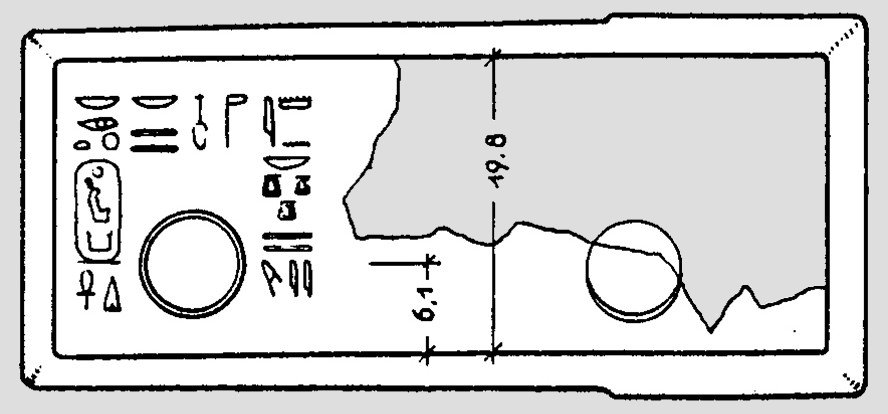
| Drawing of the destroyed pivot bearing made of dark-gray
granite showing the throne name of Hatshepsut (Ricke, 1954). Hatshepsut is
called here "nfr nTr nb t3wj nb ir.t ix-t".
It was not possible to find out where this block is today.
|
| Also the peripteros had torus rolls on both eastern corners. Moreover, fragments
lying around proved that it has had a cavetto cornice. As shown by remains the barriers
between the pillars were rounded on the top. The ceiling lay on the architraves
of the peripteros and the walls of the eastern chapel.
|
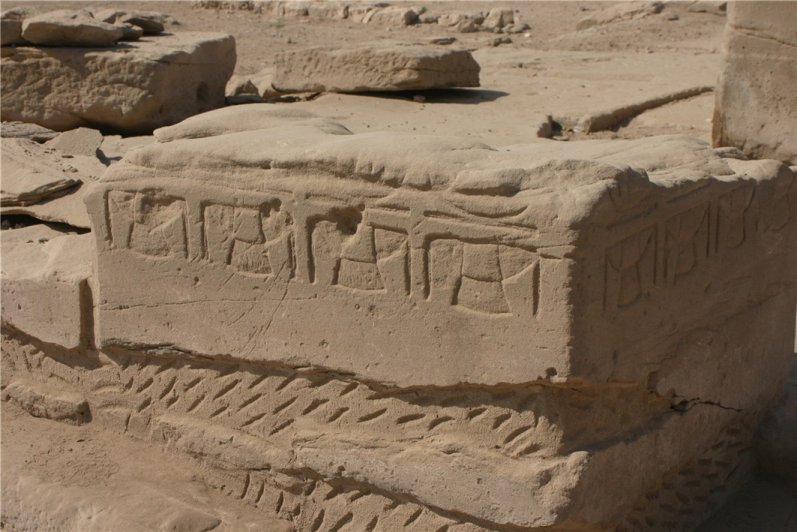
| There are only a few decorated blocks still present in the
area. The block from the corner of the eastern entrance (above) shows a row of
nwb-signs. The part of a cavetto
cornice (below)
shows the cartouches of Rameses III.
|
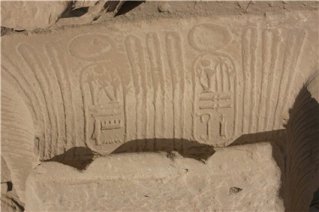
| Since the western half of the way-station was completely altered later it was
not possible to reconstruct its original execution. The foundation reveals that
the western part should have the identical width like the eastern part. On account of
numerous findings (preparatory drawings on the surface of the foundation in some
areas, scratches on the outer side of the base, remains of a group-statue which
showed an ithyphallic god between two other figures) Ricke supposed that the western part had been established as a closed construction. He
suggested an arrangement of rooms like in the small temple of Amun in Medinet
Habu, however, he expressly did not exclude another execution of construction.
Based on traces on the upper side of the foundation it is only certain that
internal walls running from the east to west must have stood where later, after
the modifications, the internal walls of the western barque shrine had stood.
|
| On account of the findings the temple can be dated unambiguously in the
beginning of the 18th dynasty. Under the eastern entrance and under both corner
pillars of the peripteros depots were found, the foundation gifts (false vase
with lids, models of meal stones, faïence plates in different colors) contained
the throne name of the Thutmosis III. On the false vase there was written "The
good God, Men-kheper-Ra, beloved [by ] Amun on his stair" which also shows
that this way-station had been dedicated to the (ithyphallic) Amun.
|
| The fact that on the later build in pivot bearing (see above) Hatshepsut herself
was called "Good God [nfr
nTr], ... " admits only the obvious conclusion that the temple was begun in the reign of Thutmosis III by the regent
Hatshepsut, but has been finished after her accession to the throne.
|
| Alterations and Extensions
|
| The question whether the rooms of the western part had really been finished,
whether a change in the plan during the execution or, in the end, an alteration
has given to the temple the final form, can not be solved anymore. Ricke favored
an alteration because the parts of east half to which the western parts had been
attached had been smoothed carefully.
|
| Only the lowest layer of the soaring masonry is preserved from the western
barque shrine and its closed gallery. The blocks were connected here with
dove-tail joints, most likely because the foundation on this side of the temple
had sunk. From the same reason some blocks of the foundation had been connected
with dove-tail joints, presumably afterwards, because on the eastern side of the
temple these joints are completely absent.
|
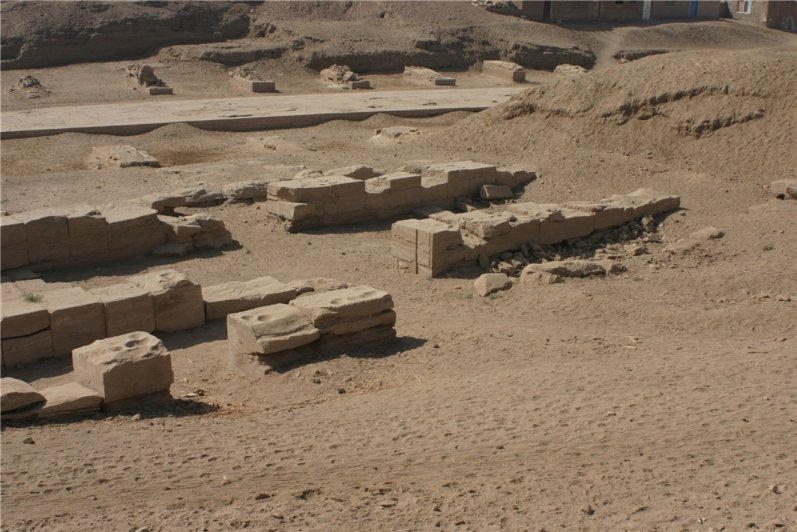
| Above the
the remains of the western barque shrine with its closed gallery.
|
| The western barque shrine (3.90 x 7.75 m) was only a little smaller than the
eastern one and resembles this so much that Ricke supposed a repetition of the
eastern barque shrine. The western side could be closed, as proved by remains of
the lower pivot bearings, by a double-winged door. On the eastern side however,
no traces were found which indicated that there had been doors.
|
| The outside walls of the closed gallery were rather thin, however, based on
other findings Ricke reconstructed a closed gallery with high walls. Why the
walls of the closed gallery were not in erected in straight line with the
pillars of the eastern gallery but moved inwards (see plan below), can not be
explained anymore.
|
| To the north and to the south of the wide passage on the west side further walls
had been built so that a closed room or court can be assumed there. In this room
or court a broad ramp whose balustrades touched on the walls of the closed
gallery led to the temple platform.
|
| In the western area of the temple a piece of a frieze of Hatshepsut was
discovered which showed her throne name and before it an Ankh sign and a
Shen-ring. Both, the Ankh sign and Shen-ring presumably belong to the well-known
Hatshepsut-cryptogram (see in also:
Djeser djeseru - Chapel of
Hathor, Valley Temple,
Other Buildings).
|
| On account of this finding Ricke has assigned the western part of the
way-station likewise to Hatshepsut. Indeed, the little fragment could also come
from the eastern part of the temple, but Ricke saw his assignment confirmed by
another finding.
|
| In the closed gallery of the western barque shrine he found in the southwest
corner a larger sandstone block which according to his view had certainly been
built in this corner. Among other things, e.g. the type of stone (sandstone)
used, it showed several deepening for
dove-tail joints which appear otherwise only in the west part of the
temple.
|
| The southern side of the block shows the remains of a king's figure which turns
to the right to a god. The falcon who glided above the king's head has been preserved
together with parts of the epigraph. Direct under the downwards pointing wing remains of a
carefully abraded inscription are still to be recognized. On the left behind
king and falcon two columns with text are to be seen of which the second line
has been altered. On account of the way how the changes had been carried out Ricke supposed that the depicted king had been Hatshepsut whose figure was
abraded by Thutmosis III.
|
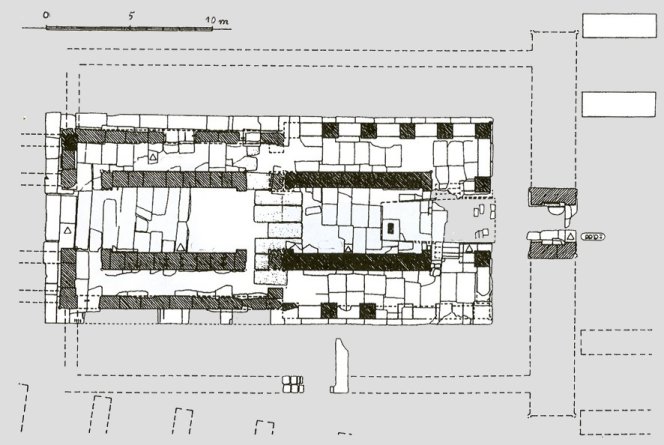
| Floor plan of the way-station after later extensions (Ricke, 1954); the dashed
lines mark the assumed position of the pylon and the enclosure wall
|
| In its last form the way-station has probably had an enclosure wall with at
least one gate on the eastern side (see plan above). Exactly on the temple axis
and in front of the eastern barque shrine Ricke found the remains of an about
2.20 ms wide gate. Because Ricke did not found any evidence of a door lintel, he
supposed that this gate had been inserted in a little pylon. This pylon measured
approx. 2.35 ms on its basis, nevertheless, its width as well as location and
expansion of the enclosure wall could not be determined. To the south of the
peripteros remains of a foundation were found which possibly belonged to a door
in the enclosure wall, but they could also come from a later extension.
|
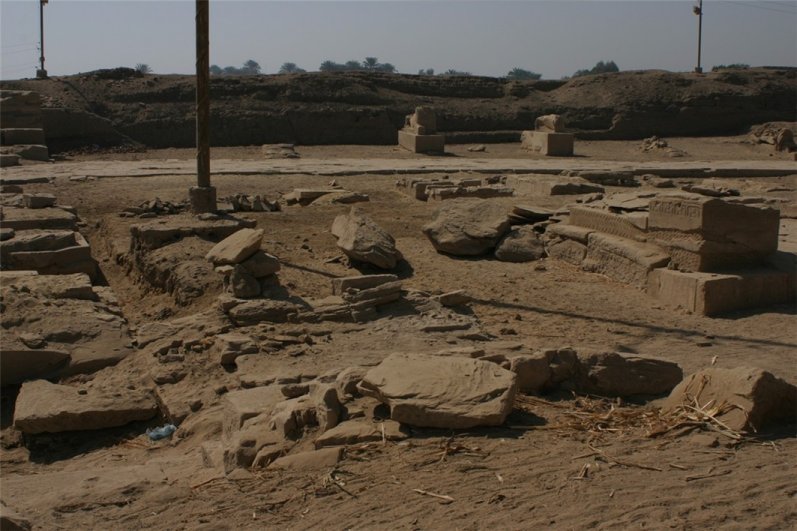
| View on the pylon squeezed in between the avenue of sphinxes (left)
and the entrance of the way-station (right). At the southern end of the pylon
the administration of Luxor City has planted an electricity pylon.
|
| The pylon has become squeezed in between the avenue of sphinxes and the
way-station. To create the necessary space, the eastern ramp was taken down and
moved into the temple. Because the ramp could not compensate for the different
levels, the eastern part (i.e. the floor) of the gallery was lowered. At the
same time steps were built in the peripteros and also a ramp leading from the
eastern part of the gallery into the barque shrine to compensate for different
levels (see following photos). On the south of the temple axis a block of the ramp shows a
careless carved rectangle with "Nine Bows" - obviously marking the place where
the king stood during the rites.
|
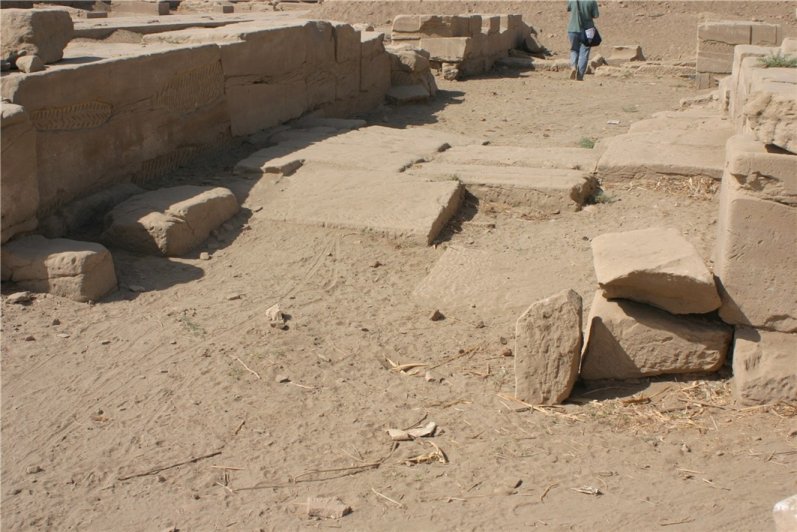
| Above two sloping blocks of the ramp moved into the first
shrine, below a step built
into the left gallery to compensate for the different floor levels.
|
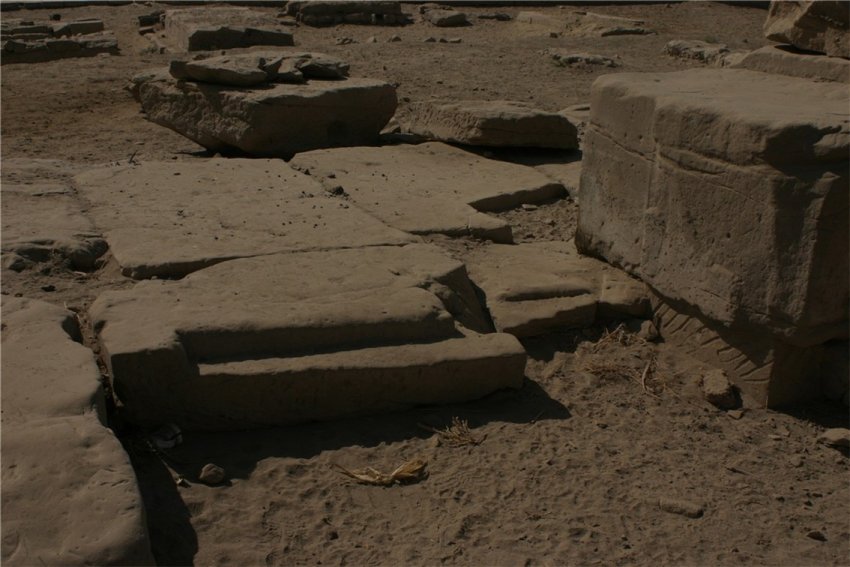
| Based on the history of architecture Ricke dated the erection of pylon and gate
between "at the earliest under Amenhotep III" and before the "late-Ramessid
period".
|
|













